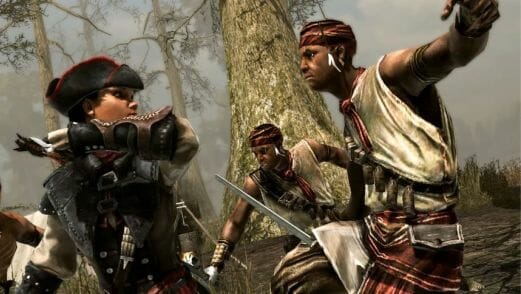Assassin’s Creed Liberation HD (Multi-Platform)

The crude outlines for the game that Assassin’s Creed: Liberation HD was intended to be are evident throughout Ubisoft’s console port of the 2012 Vita game. The bite-sized, commute-ready missions feel spare, halting and repetitive when played in chunks. The narrative, which aims for a narrower scope than AC games past, feels not only thin but kind of patronizing as it uses slavery as window dressing for the adventures of the series’ first heroine. After the creative and mechanical evolutions of the series found in Black Flag, Ubisoft’s decision to bring Liberation HD to consoles is a reminder of some of the worst mechanical and narrative problems of the long-running franchise.
Taking place in the late 18th century, Liberation serves as a companion game of sorts for Assassin’s Creed III, using the growing pains of the American Revolution as the backdrop for the latest skirmish between the Templars and the Assassins. While Connor is up north battling a wide-ranging plot to subvert the revolution, Liberation heroine Aveline de Grandpré must battle the poorly voice-acted French and Spanish conspirators attempting to do… something.
Between the colony of grinning, unwitting slaves to the relegation of nearly every person of color to a lackey or stooge, Liberation is possibly trying to say something about one of the nation’s greatest sins but has neither the conviction nor coherence to do so (and it’s unclear why the only two games in the franchise to feature characters of color in the lead felt the need to somehow mitigate the choice by making them half-white). And the mess that is Liberation’s story is only matched by the weakness of its play.
It’s similarly unfortunate that the first game with a female lead would feature what essentially amounts to a dress-up mode. The Persona system—which allows Aveline to switch between her assassin’s costume, a slave costume and a lady’s fancy dress—theoretically offers an extra layer of strategy in Liberation, with each of the identities offering their own sets of skills and separate wanted levels. The Lady persona, for instance, doesn’t have access to weapons or the assassin’s sweet parkour moves, but she can charm some guards and it’s much harder for her to build up a wanted level. The Slave, meanwhile, can pick up crates and mingle with other slaves while largely retaining the moves and some of the weapons of the higher-profile Assassin persona. It’s a smart idea which would be a strong mechanic if the player was empowered to use the personas as a tactic in the game in any way. Instead, Aveline will simply be told to go to one of the ubiquitous changing rooms to swap into one of her personas for the next story junction.
This is largely a function of the way the breakneck Liberation is structured, pushing its heroine from one disjointed encounter to the next with little room for (or encouragement of) exploration. The action is split between the hustle and bustle of the New Orleans hub, the swamps outside of the city, and a colony in Mexico. Between the disproportionately high number of missions involving tailing subjects, to a couple of trippy combat sequences, to gaming’s worst canoe ride, Aveline is hurtled through Liberation like she’s strapped to a theme park ride. The game isn’t structured so that we can understand or get to know the New Orleans of the late 1700s, but because the designers have ideas for set-pieces that would work in a swamp or heavy rapids or near a pyramid.
-

-

-

-

-

-

-

-

-

-

-

-

-

-

-

-

-

-

-

-

-

-

-

-

-

-

-

-

-

-

-

-

-

-

-

-

-

-

-

-









































